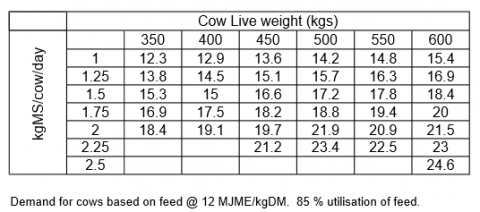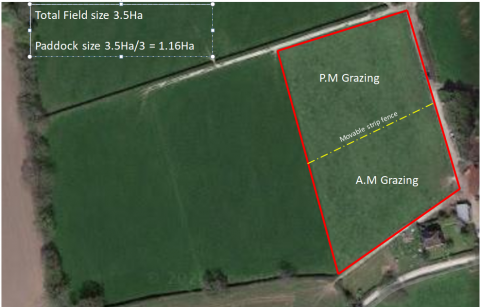26 March 2020
Rhys Davies, Farming Connect Dairy Technical Officer
It is important that the cow has an edge to her appetite, therefore, ensuring cows have cleaned up any silage two hours prior to morning milking and holding cows back on the yard for a period will ensure the whole herd’s behaviour is geared up to grazing. Often during periods of wet spring weather, the herd will only be able to graze for a few hours in the day and will be brought back in at night, therefore, in unsettled weather the cow’s rumen will transition naturally. However, during drier prolonged weather or due to a lack of ensiled forage, it may be tempting and necessary to turn out to grass from silage in one move. This should be avoided. Planning the last of your silage stocks along with careful weather forecasting a few weeks in advance will ensure there is a gentle transition between forages, giving time for rumen microbes to adapt.
When cows are out grazing full time, milkers are at high risk of grass tetany (staggers), particularly on re-growing, lush grass which is rich in potassium and nitrogen and during cold and wet weather. Cows need to be supplemented with 30g of magnesium per day during this high risk period. This can be done through mineralising their blend or cake or through magnesium chloride flakes in their water.
CALCULATING AREAS TO GRAZE
Calculating the daily grazing area a herd requires in order to graze down to the optimum height for subsequent regrowth and to ensure correct level of cow intakes can be a combination of, trial, error and practice to get right. Understanding and knowing some key numbers from the offset will help you get your grass allocation as accurate as possible. Having turned out to a sacrifice paddock and transitioned from silage to grass over a number of days, a cow’s behaviour and rumen will be ready for grass as the largest proportion of her diet.
There are different grazing options that include allocating fresh areas every 12, 24 or 36 hours. It is recommended that 12 hour grazing areas should be given to herds that graze in the summer and house in-milk cows during winter. For peace of mind and avoid unsettled cows at night, farmers can allocate slightly more area after the PM milking compared to the AM milking e.g. a 60/40 night and day split of the allocated daily area.
Grass utilisation of a given area is an important factor when calculating allocation. This is the percentage of the grass allocated that actually ends up inside the cow’s stomach and not wasted. Well versed grazing herds of cows that feed on little or no supplementation can achieve >90% utilisation, however, most herds will achieve 75%-85% utilisation of grass.
Cow type, size and yield will dictate what the likely dry matter (DM) intakes will be each day.
Table 1 below will give an indication of total kgDM intake per cow. However, a cow physically will not be able to intake more than approximately 18kgDM/day, therefore, herds with large high-producing cows often need supplementation and buffer which then may lead to poor grazing behaviour. It is also important to note that dry matter % of the sward changes throughout the grazing season. GrassCheck GB and AHDB’s Forage for Knowledge are great online resources to keep an eye on grass quality in your area.
Table 1. Dry matter intakes per cow based on liveweight (kg) and production (kg of milk solids) per cow per day.
Source: AgriNet
To help understand daily allocation, the example herd and paddock below will demonstrate the process of calculating grazing areas.
Herd size 80 cows @ 550 kgLW
Producing on average 2kgMS/day throughout the grazing months
Daily Cow requirement 20.9kg DM/day
Concentrate fed 4kgDM/head/day
Utilisation 85% (which is assumed in the table value)
Daily cow requirement from grass 16.9kgDM/day (20.9kgDM – 4kgDM)
Total herd requirement from grass per day 1,352kgDM/day
If the herd enter the paddock at approximately 3,000 kgDM/ha and leave the paddock at 4cm, each hectare offered will have a residual of 1,500kgDM available.
Total herd requirement (1,352kgDM/day)
____________________________________________ = 0.90 Ha/day
Grass available per hectare
(cover in 3,000 minus the cover out 1,500 = 1500kgDM)
This means the herd will need just over a hectare per day 0.90 ha/day at 3,000kgDM/ha grass cover.
Knowing the total daily area required can be used in conjunction with a farm map to work out areas for strip fencing daily allocation or to plan more permanent paddocks. It should be noted that cows walking over already grazed areas should be minimised. If this occurs over a number of days in larger fields, they can be tempted to graze regrowth and under-utilise that day’s fresh allocation. Both can reduce total grass growth and utilisation. There are GPS apps available on smartphones to help with planning area allocations.
The map below shows how a field can be split into 3 paddocks with the correct daily area allocated for the 80-cow example herd; this is based on fresh grass available after each milking. Farmers could give a slightly larger allocation in the evening, in this example 0.54ha (0.9ha x 0.6) after the PM milking and 0.36ha (0.9 x 0.4) the following morning.
Figure 1. An example of a field split into three daily paddocks with wooden posts and high tensile wire. Each paddock is split into two grazings.
If herds enter at lower covers e.g. 2,800kgDM then the daily area allocation needs to be greater as there is less feed available per hectare. Likewise, if cows enter larger covers of e.g. 3,200kgDM then smaller areas will be needed. However, utilisation of larger covers tends to be less than lower covers and care needs to be taken if a cow’s grazing behaviour is not suited to these heavier swards.
Other useful resources that might be of interest
Interactive e-learning modules
https://businesswales.gov.wales/farmingconnect/business/skills-and-training/e-learning
Technical articles from our Knowledge Exchange Hub
https://businesswales.gov.wales/farmingconnect/business/knowledge-exchange-hub
Demonstration Site Project
https://businesswales.gov.wales/farmingconnect/our-farms/projects/erw-fawr
Farming Connect Ear to the Ground Podcast
https://businesswales.gov.wales/farmingconnect/business/ear-ground-podcast


